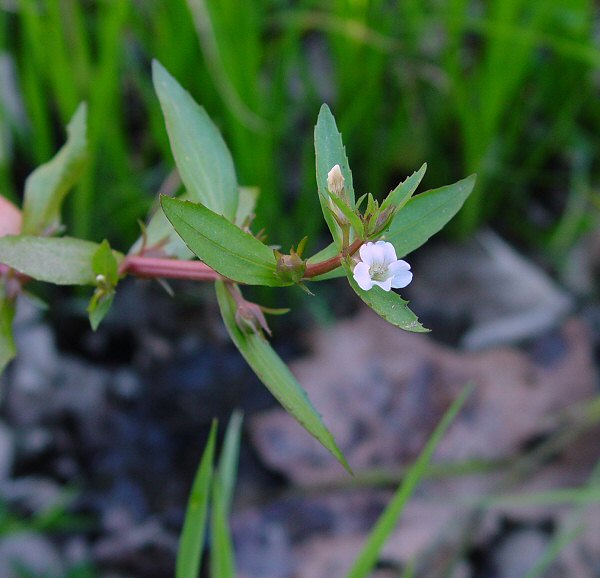Gratiola virginiana L.
Round-Fruited Hedge Hyssop

Native
CC = 8
CW = -5
MOC = 34
© DETenaglia
Gratiola virginiana L.Round-Fruited Hedge Hyssop | |
 |
Native CC = 8 CW = -5 MOC = 34 |
© DETenaglia |
|
Family - Plantaginaceae Habit - Annual forb with fibrous roots, these sometimes fleshy. Stems - Ascending or erect from a spreading base, sometimes prostrate following inundation and developing ascending branches thereafter, to 50 cm, stout, inflated and spongy, glabrous.
Leaves - Opposite, simple, sessile, glabrous. Blades 1.5-5.0 cm long, narrowly lanceolate to more or less elliptic, those of the lower (often submerged) leaves usually narrower and grading into the broader emergent leaves toward the stem tips, those of emergent leaves broadest at or above the midpoint, narrowed basally and not clasping the stems (those of the lower leaves often broadest below the midpoint and clasping the stems), rounded to more commonly bluntly or sharply pointed at the tip, the margins entire or with few to several, shallow, blunt to sharp teeth,
Inflorescence - Axillary, with 1-2 flowers per node.
Flowers - Perfect, subtended by bractlets. Flower stalks 1-4 mm long, becoming elongated to 9-14 mm long at fruiting, relatively stout, minutely glandular-hairy to nearly glabrous. Bractlets 2-6 mm long, linear to very narrowly elliptic. Calyces 3-6 mm long (often becoming slightly enlarged at fruiting), the lobes lanceolate to narrowly oblong-lanceolate, the margins entire. Corollas bilabiate, 8-14 mm long, the tube longer than the lobes, usually slightly arched upward, the upper lip nearly straight to somewhat recurved very shallowly notched or 2-lobed, the lower lip straight to somewhat spreading or slightly arched upward, with 3 deeper lobes, cream-colored to pale yellow externally with dark purple to dark brownish purple venation, the throat and lobes white to pale lavender-tinged. Fertile stamens 2, the filaments not exserted, staminodes usually present, appearing as a pair of antherless filaments. Style 1, not exserted, forked near the tip, the short branches flattened and broad.
Fruits - Globose capsules 3-6 mm long, slightly shorter than to about as long as the calyces.
Flowering - April - October. Habitat - Swamps, sloughs, ponds, marshes, ditches. Origin - Native to the U.S. Lookalikes - Gratiola neglecta, Lindernia dubia. Other info. - This species is found scattered across much of Missouri, but is relatively uncommon. Its continental U.S. distribution is also somewhat scattered, ranging throughout the southeastern region of the country. The plant is sometimes largely submerged in stagnant water, with only a small portion of flowering stem emerging above the surface. The lower stems in particular are large and spongy, but relatively weak. The spongy, glabrous stems and narrowed leaf bases serve to distinguish this species from its lookalikes. Photographs taken at Davis Ferry, Monroe County, AL., 3-25-06 (DETenaglia); also at Otter Slough Conservation Area, Stoddard County, MO, 4-22-2019 (SRTurner). |